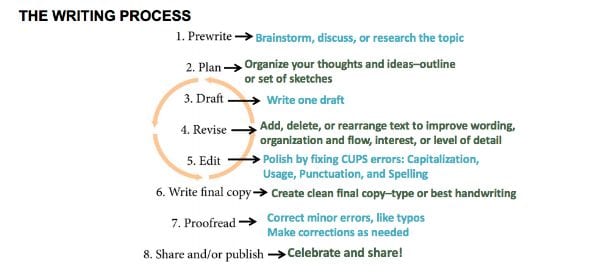Building Proficient Writers Requires a Foundation in the Basics
Too often when teachers say they are teaching writing, they mean that they are assigning writing work to their students, but they aren’t actually helping students master the fundamentals. From grammar and spelling basics to writing thesis statements and revising drafts, every step of the process is essential for developing confident writers who can effectively communicate their ideas. Based on several research reports, Jenny Hamilton, M.Ed., an independent literacy consultant, has identified best practices for writing education, which she shared in the recent edWebinar, “Strategies for Building Proficient K–12 Writers.” Overall, the goal is to break down writing into its essential elements, giving students the opportunity to master them before drafting essays and reports.
First, students should have a strong background in the structures of writing, such as spelling, punctuation, and basic grammar. In addition, teachers should spend time looking at individual sentence and paragraph construction. For example, what makes a good topic sentence? How do you connect the sentences in a paragraph to each other? What adjectives and adverbs convey what emotions to the reader? Thus, students are able to pay more attention to the content of their writing because they understand the foundations.
Then, students can move on to prewriting. As part of prewriting students need to be able to interpret a writing prompt. They should be able to say in their own words what the teacher is asking them to do. Teachers need to work with their classes to identify the key asks in a prompt and how that narrows the scope of the assignment.
Next, still in the prewriting phase, educators should work on how to brainstorm. Students may be worried about coming up with right and wrong answers. The goal is to make them comfortable with sharing ideas and to have content that will let them move forward in the process. Brainstorming can also help identify areas where students need to do more research.
Once students have sufficient ideas, they need to learn how to plan their writing. Hamilton said many students get stuck on the idea of an outline because it seems too rigid and focuses more on Roman numerals than the actual content. She suggested looking at a variety of methods that allow students to move around their content and recognize how it’s addressing the assignment.
Now students are ready to write a draft, but Hamilton says students shouldn’t see this as just the rough draft or as a step that’s completed once the last sentence is written. Instead, she sees writing, revising, and editing as a continuous cycle that only ends when the student is ready to create the final copy. Depending on the assignment, students may share early drafts and even be asked to peer edit. Hamilton believes, though, that students need lessons in providing feedback before they can be inserted into the process. If students haven’t been taught how to comment on each other’s writing in a productive manner, then the peer feedback might not help the student improve their work.
The most important piece of this writing strategy, though, is the timing. Each of the steps should be discussed over multiple days in multiple lessons. For example, teachers should not talk about brainstorming one day and then planning the next. They should ask students to brainstorm about different topics every day until the students are able to lead the process themselves. Then, they can learn about the planning stage. Give students small moments of success so they develop a positive attitude towards writing.
Moreover, this process should also repeat itself over a student’s education career. “What the research told me … is that writing instruction really isn’t that different depending on the student. It’s not like I’m going to teach writing [that will be] something very different for a tenth grader than for a first grader,” said Hamilton. “The elements of good writing will always be there. It’s the level of sophistication. It’s the depth of knowledge that I’m seeking that really changes. The basics tenets of good writing really don’t change.”
This broadcast was hosted by edWeb.net and sponsored by Voyager Sopris Learning®
This article was modified and published by eSchool News.
About the Presenter
Jenny Hamilton, M.Ed. has been a tireless advocate for students who struggle to achieve academic success. Her training and background in behavior management enables her to share practical solutions regarding classroom management issues. She also works with teachers to raise awareness of the emotional damage that accompanies academic failure. Jenny’s depth of experience in teaching elementary, middle, and high school students lends authenticity to her delivery when she trains and coaches teachers. A deep interest in the research behind best practices and the science of learning allows her to share with teachers and administrators current and relevant data on how the brain works and what can be done to change the trajectory of struggling readers and writers. She is currently an independent consultant focusing on literacy.
Join the Community
Literacy and Critical Thinking is a free professional learning community where educators work together to develop their students’ reading proficiency and critical thinking skills, two related and essential skill areas that all children need to master in order to succeed in life.
Voyager Sopris Learning is part of the Cambium Learning® Group, a leading educational solutions and services company committed to helping all students reach their full potential. Voyager Sopris Learning provides innovative, evidence-based instructional solutions and professional development services to preK-12 students and their teachers.





Comments are closed.